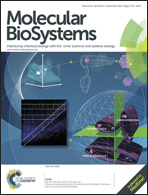A new approach combining LC-MS and multivariate statistical analysis for revealing changes in histone modification levels†
Abstract
While acting upon chromatin compaction, histone post-translational modifications (PTMs) are involved in modulating gene expression through histone–DNA affinity and protein–protein interactions. These dynamic and environment-sensitive modifications are constitutive of the histone code that reflects the transient transcriptional state of the chromatin. Here we describe a global screening approach for revealing epigenetic disruption at the histone level. This original approach enables fast and reliable relative abundance comparison of histone PTMs and variants in human cells within a single LC-MS experiment. As a proof of concept, we exposed BeWo human choriocarcinoma cells to sodium butyrate (SB), a universal histone deacetylase (HDAC) inhibitor. Histone acid-extracts (n = 45) equally representing 3 distinct classes, Control, 1 mM and 2.5 mM SB, were analysed using ultra-performance liquid chromatography coupled with a hybrid quadrupole time-of-flight mass spectrometer (UPLC-QTOF-MS). Multivariate statistics allowed us to discriminate control from treated samples based on differences in their mass spectral profiles. Several acetylated and methylated forms of core histones emerged as markers of sodium butyrate treatment. Indeed, this untargeted histonomic approach could be a useful exploratory tool in many cases of xenobiotic exposure when histone code disruption is suspected.


 Please wait while we load your content...
Please wait while we load your content...